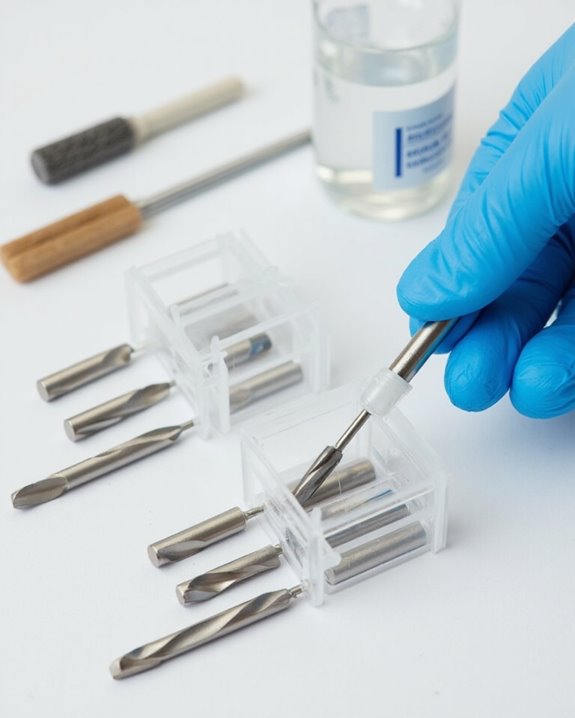For cuticle work, I recommend ball-shaped bits (1.8-2.34mm diameter) to safely clean around sidewalls without damaging the nail bed. Diamond bits offer gentle exfoliation while carbide UNC bits provide precision for stubborn areas. Safety bits with rounded tops protect sensitive skin during cleaning. Always operate at low to medium speeds (never exceeding 60,000 rpm) and use short, controlled movements with light pressure. Proper bit selection guarantees effective removal of only dead tissue while preserving the essential eponychium below.
Key Takeaways
- Ball head bits are ideal for cuticle work, available in both fine and coarse grits for removing dead tissue without damaging living skin.
- UNC bits with pointed carbide construction excel at accessing sidewalls and removing dead cuticle in tight spaces.
- Flame bits work effectively for opening cuticle pockets and clearing debris from the nail perimeter.
- Diamond bits offer gentle exfoliation for sensitive skin while carbide bits provide more power for stubborn cuticle areas.
- Safety bits with rounded tops protect against accidental nicks while operating at low speeds (under 60,000 rpm) prevents heat damage.
Numeric List of 9 Second-Level Headings
These nine essential nail drill bits will transform your cuticle care routine, helping you achieve salon-quality results at home. When selecting the right bit to clean and remove cuticles, I recommend starting with the Ball Bit, which effectively addresses the Eponychium without damaging the nail plate.
For precise work around sidewalls, consider the Safety Bits with their rounded tops or the Cone bit with its tapered design, particularly effective on toenails. Diamond bits, operating at up to 60,000 RPM on low settings, provide gentle cuticle removal with options like the 1.8mm ball head. For intricate cuticle work in tight spaces, the UNC bit (Needle bit) excels with its pointed design, accessing under nail edges with accuracy. Carbide bits round out your collection, offering durability for professional-level cuticle maintenance. Additionally, selecting bits with strong torque ensures consistent performance during detailed cuticle work, reducing the risk of accidental damage.
Understanding the Anatomy of Cuticles and Their Care

Before selecting the ideal nail drill bit for your cuticle work, you’ll need a clear understanding of what you’re actually treating. The cuticle consists primarily of the eponychium, a protective layer of hard skin above the nail plate that forms a vital seal against bacteria and infection. When I’m working on the cuticle area, I’m targeting only the dead cuticle and hard skin without damaging the living tissue beneath. The ball-shaped bit offers precise cleaning around the sidewalls and nail bed while helping avoid lifting of the eponychium. This bit gently exfoliates non-living tissue while maintaining the integrity of your natural nail. Remember, effective cuticle care isn’t about removing the entire cuticle, but rather carefully addressing only the excess dead tissue that can accumulate along the perimeter. Using the appropriate drill bits and techniques ensures safety and optimal results.
Essential Types of Nail Drill Bits for Cuticle Work
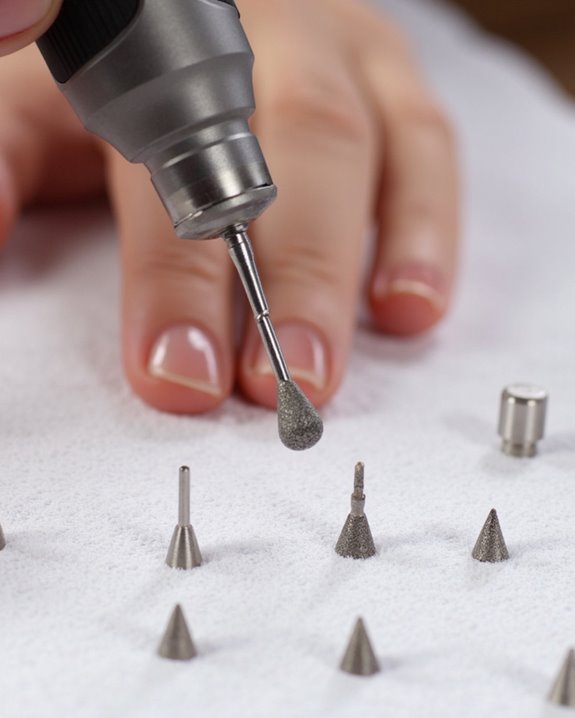
The right nail drill bit can transform your cuticle work from potentially damaging to precisely effective, making bit selection essential for professional results. I recommend starting with the Ball Head bit, specifically designed for cleaning the Eponychium and removing loose cuticle tissue from the cuticle area. For tighter spaces, the UNC bit (needle bit) proves invaluable, with its pointed carbide construction perfect for accessing sidewalls and removing dead cuticle without nail damage.
The Flame bit excels at opening the cuticle pocket and clearing debris, while tapered barrel and cone bits, with their slim design, work effectively around the nail perimeter. Safety bits, featuring rounded tops, offer protection during cuticle cleaning tasks, making them ideal for beginners who want to minimize risks while still achieving professional cuticle care results.
Ball Bits: The Gentle Giants for Cuticle Maintenance
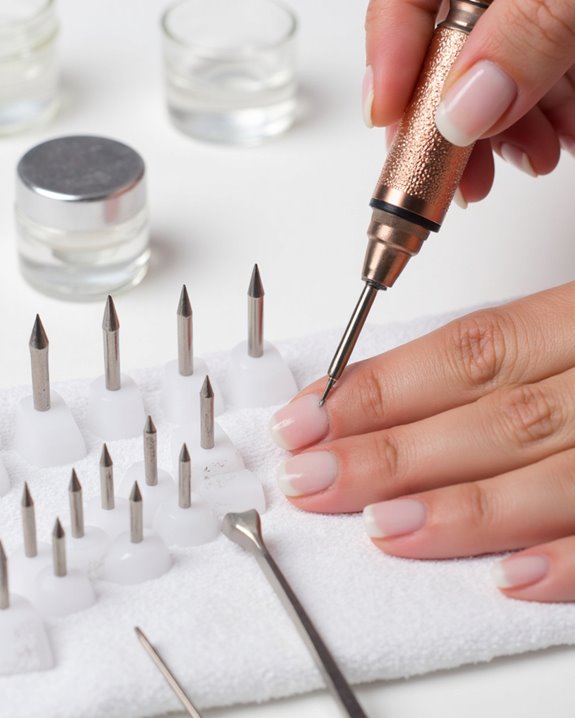
Among all the cuticle-care instruments we’ve examined, ball bits stand out as true gentle giants in the manicure world. I’ve found their specialized design perfectly accommodates the tight spaces around sidewalls without damaging the nail bed beneath. With diameters of 1.8 mm and 2.34 mm, these diamond or carbide bits offer precise access to the cuticle area, effectively removing dead skin and loose tissue. Their consistent RPM performance and versatility make them suitable for both beginners and professionals. What makes these bits exceptional is their ability to clean the cuticle at speeds up to 60,000 rpm on low to medium settings, safely exfoliating the skin around the nail. I particularly recommend the Cuticle Bit Ball Coarse, which consistently earns 5-star reviews for its effectiveness on dead cuticle tissue. For those with sensitive skin, the fine-grit Refine Ball Bit gently prepares the cuticle area while supporting a chemical-free technique suitable for all ages. Proper bit maintenance enhances their longevity and performance, ensuring safe and effective cuticle care.
Safety Bits: Protective Options for Sensitive Cuticle Areas
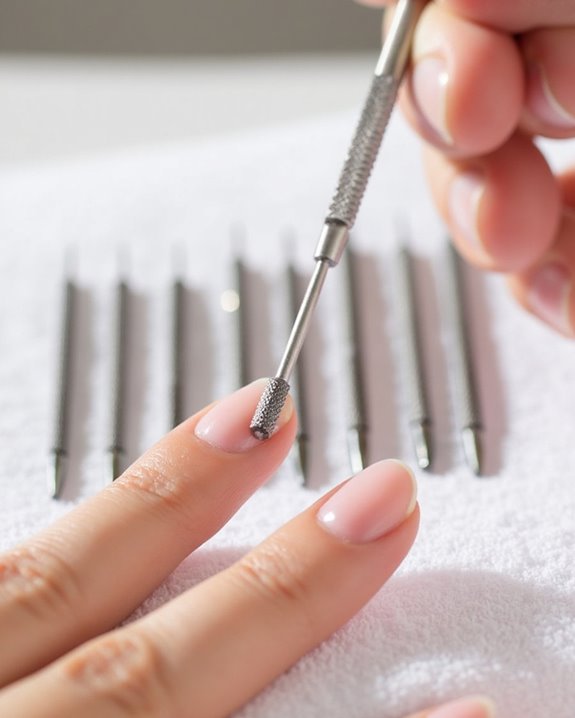
When working with delicate cuticle areas, why not consider safety bits as your go-to protective option? I’ve found that these high quality bits, rounded at the top, are specifically designed to protect sensitive skin while effectively preparing the nail. The Smooth Top safety barrel, like Kiara Sky’s medium grit option, allows me to work around sidewalls and in-fill cuticle areas without damaging living tissue.
What makes these ceramic bits exceptional is their ability to gently remove non-living tissue at lower speeds (up to 60,000 RPM). When placing the bit in the cuticle area, the rounded design prevents accidental nicks or cuts. I’ve noticed they’re particularly great for in-fill cuticle work, as they maintain nail integrity while providing precise access to those hard-to-reach spots.
Diamond vs. Carbide: Material Considerations for Cuticle Bits
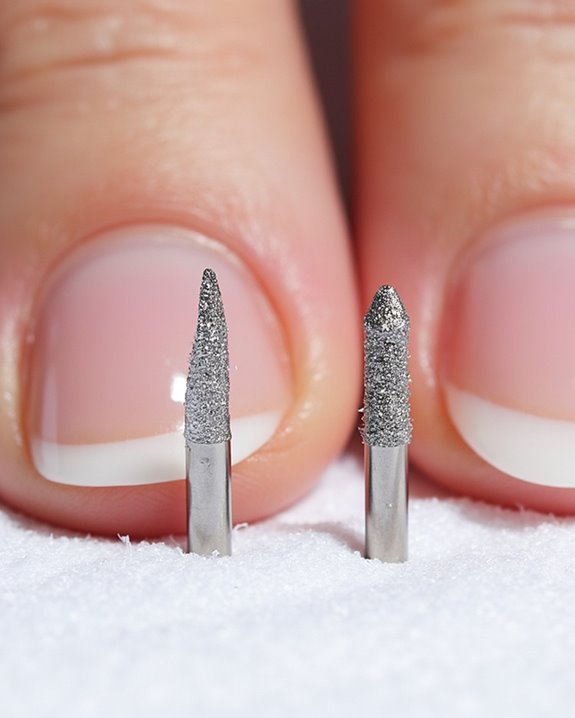
How do you choose between diamond and carbide bits for your cuticle work? I’ve found that the different materials of nail drill bits greatly impact performance when addressing the cuticle area and sidewalls. Diamond bits are made of metal coated with diamond particles, ideal for gently removing dead cuticle without causing trauma to sensitive skin. They generate less heat and offer precise control for detailed work.
In contrast, flame carbide bits, made of metal or rubber with carbide cutting edges, deliver powerful performance when used to clean stubborn areas. While high-quality bits of both materials work effectively, carbide options typically last 150-300 services and can withstand speeds up to 60,000 RPM. Diamond bits excel for delicate work but require replacement more frequently, making material selection critical for both safety and efficiency.
Speed and Technique: Mastering Drill Control Around Cuticles
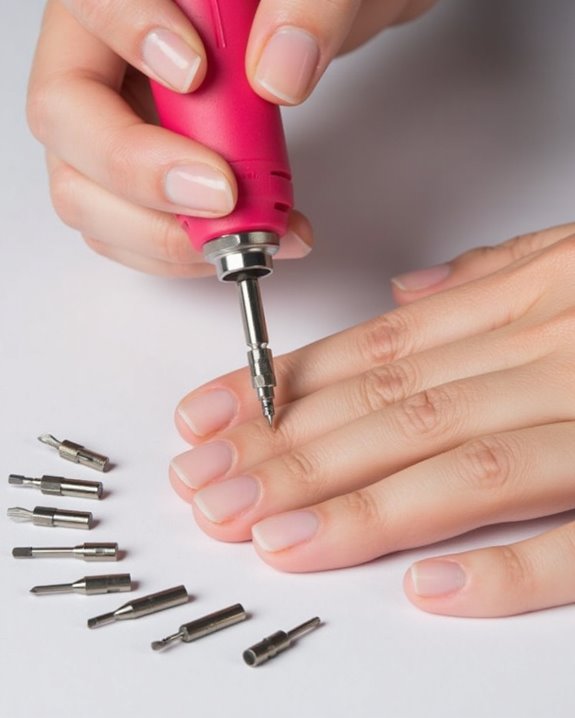
The perfect speed and proper technique create the foundation for safe cuticle work with nail drills. I recommend operating at low to medium speeds, never exceeding 60,000 RPM, which provides ideal control when removing dead cuticle tissue or addressing that stubborn lip of dead cuticle around the nail plate. For drill control, rest your working hand on a stable surface while executing short, controlled bursts rather than continuous drilling. This approach keeps your bit from overheating and is great for removing hangnails.
UNC bits and flame bits are pointed and small, perfect for precise maneuvering, but require exceptional drill control. Whether using these specialized shapes or standard diamond bits, remember that light pressure combined with proper speed guarantees you remove product efficiently without damaging the natural nail bed.
Preventing Damage: Common Mistakes to Avoid With Cuticle Bits
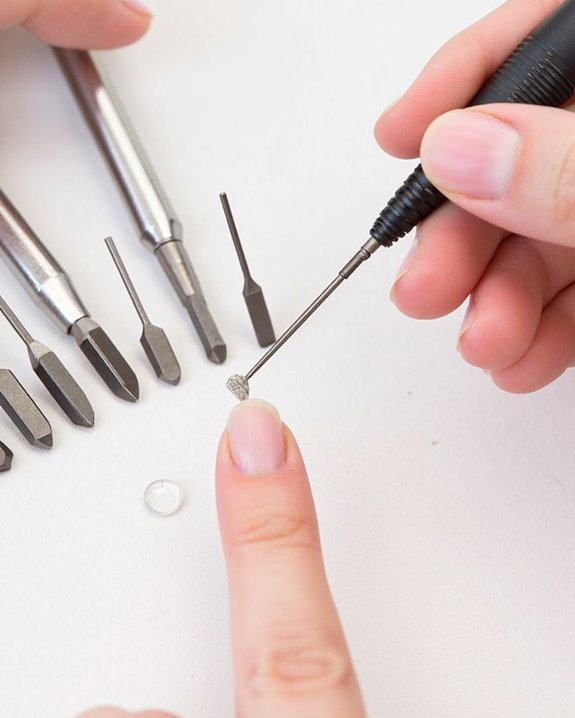
Despite their effectiveness for cuticle care, nail drill bits can cause significant damage if used improperly around these sensitive areas. I always recommend using safety bits with rounded tops rather than standard barrel bits, which can accidentally cut into skin when working near the cuticle. The UNC bit is specially designed for this delicate work, whereas cylinder bits should never contact this sensitive tissue.
Don’t run your cuticle bits at high speeds or for extended periods, as this creates heat that can burn skin. I’ve seen too many technicians apply excessive pressure with quality bits, eroding natural nail layers unnecessarily. After each session, use a cleaning brush on your nail bits to remove debris, but avoid extended soaking which damages the bit’s coating and compromises safety during future treatments.
Professional Tips for Extending Cuticle Bit Lifespan
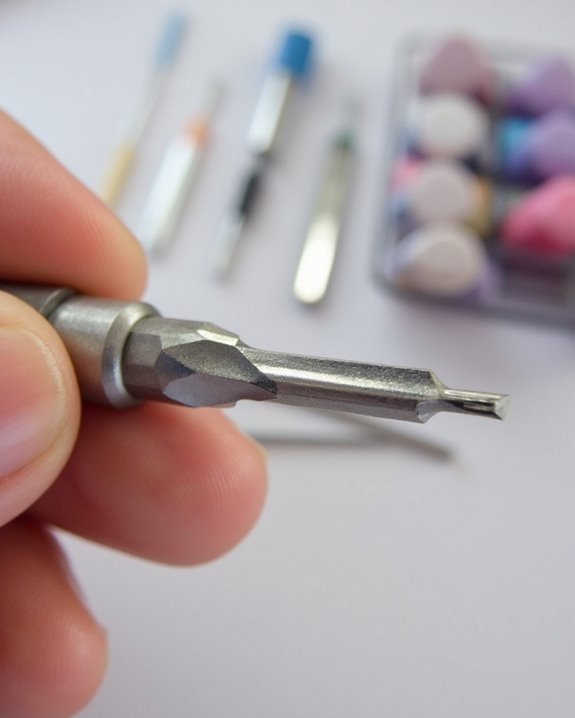
Preserving your cuticle bits through proper care can drastically extend their service life, transforming them from short-lived tools into long-term investments. I’ve found that properly maintaining your professional nail drill bits, whether made of rubber, metal, or other materials, can extend their lifespan from 150 to 300 services. After each use, clean your High quality bit with a small brush, soap, and warm water to remove debris that would otherwise reduce longevity. When disinfecting, especially diamond or carbide UNC bits (which are pointed), follow label instructions precisely to avoid eroding their coating.
To make your life so much easier, store bits in a proper case, avoid high RPMs for extended periods, and make sure they’re completely dry after cleaning. This thorough Guide To Nail Drill bit maintenance will help preserve your valuable variety of materials.
Frequently Asked Questions
Which Drill Bit Do You Use for Cuticles?
80% of nail techs prefer Ball Top Shape bits for cuticles. I’d recommend safety bits with rounded tops for your cuticle prep. Use low speed settings (under 60,000 rpm) and maintain proper drill hygiene for bit durability and safety.
Can You Use a Nail Drill on Cuticles?
Yes, I can use a nail drill on cuticles with proper safety precautions. I’ll use specialized safety bits, avoid skin irritation by using low speeds, and prevent nail damage by mastering my technique. Professional advice recommends careful home use.
What Bit Do I Use to Seal My Cuticle?
For sealing my cuticle, I’d recommend a ball top safety bit. After using, I apply cuticle oil as a natural sealant, creating a hydration seal. Regular moisturizing routine with barrier cream maintains that protective layer.
Which E-File Bit Is for Cuticles?
Ever wondered which tool makes cuticle magic? I’d recommend safety bits with rounded tops or ball-shaped diamond cuticle bits. They’re perfect for gentle cuticle work! Just adjust your e-file speed and consider grit levels for best results.



